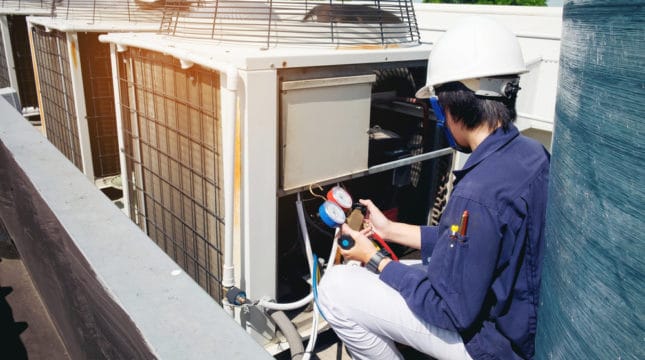Insurance for HVAC licensed contractors in California
Depending on the nature of your business, you’ll need business insurance in California to maintain your license. The following are the key types of HVAC insurance to consider.
Workers’ compensation insurance
The CSLB requires licensed contractors in California to submit a certificate of insurance as proof of workers’ compensation insurance coverage. Workers’ comp coverage can help provide wage protection and other benefits if you or your employees get hurt on the job.
The certificate must include the following:
- Name and contact information of the submitting contractor
- Contractor’s business name
- Insurance company name
- Policy number
- Policy effective date and expiration date
- Contractor’s CSLB-issued license number
- CSLB listed as the certificate holder
- Handwritten or stamped signature
General liability insurance
If you own a limited liability company (LLC), you’re required to obtain general liability insurance in California for your HVAC business. This insurance can help provide coverage for some of the most common accidents at a business, including property damage and if someone other than an employee gets hurt.
Tools and equipment insurance
Tools and equipment insurance is valuable repair and replacement coverage if something happens to your work gear, like damage or theft.
Commercial auto insurance
Commercial auto insurance can help cover costs related to accidents involving your work vehicle, such as property damage or medical expenses.
Commercial property insurance
Commercial property insurance in California can help cover costs related to damage or vandalism affecting property you own or rent for your business.
California HVAC contractor license requirements
In order to apply for a license, you’ll need to fulfill the following California HVAC license requirements:
- Be at least 18 years old
- Have a Social Security number or individual taxpayer identification number
- Complete at least four years of journey-level work experience in the last 10 years
Your application must include details of your professional experience. Additionally, a certifier (such as an employer, foreman or supervisor) will have to fill out a section of the application to verify your work experience.
The wait times for applications vary based on a number of factors. It often takes several months for the California Contractors State License Board to process new applications.
You can check your application status online on the CSLB website. You’ll receive a “Notice to Appear for Examination” after your application has been reviewed and accepted.
California HVAC licenses are valid for two years. You’ll receive a notification from the CSLB about 60 days before the expiration date, including instructions on renewing your license. Currently, the cost of California HVAC license renewal is $450.
California HVAC license reciprocity
If you have an active HVAC license in Arizona, Louisiana and Nevada, you may be eligible for HVAC license reciprocity in California.
If you qualify for reciprocity, the CSLB will waive the trade exam requirement. However, you’ll still need to submit verification of your work experience and pass the CSLB law and business exam.
How NEXT helps support California HVAC contractors
NEXT can help you get the correct insurance to fulfill California requirements, get your license and help protect your business. We’re 100% dedicated to helping small businesses and self-employed workers with customized insurance packages at affordable rates.
Apply for coverage and get a certificate of insurance in under 10 minutes. Our online services are available 24/7, which means we’re here to help anytime, anywhere.
Start a free quote with NEXT.







